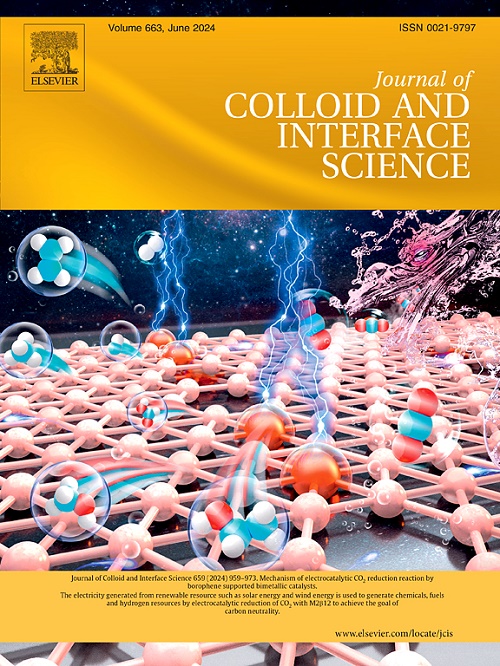Artificial light-harvesting system with sequential energy transfer in photocatalytic CP coupling based on supramolecular organic framework of triphenylamine
IF 9.7
1区 化学
Q1 CHEMISTRY, PHYSICAL
引用次数: 0
Abstract
Porous structures exhibit an increased access surface area, thereby promoting the efficient transportation of active oxygen species. Reinforcing the development of artificial light-harvesting systems (LHSs) with porous structured supramolecular organic frameworks (SOFs) as the energy donor can significantly enhance its photocatalytic performance, thereby facilitating efficient organic transformation via photocatalysis. In this investigation, we have successfully fabricated a supramolecular organic framework (MT-SOF) composed of cucurbit[8]uril (CB[8]) and triphenylamine derivative (MeTPPA). Because of the framework structure and large ring restriction in MT-SOF, its fluorescence emission shows a significant increase when compared to that of the individual MeTPPA molecule. By harnessing the remarkable fluorescence emission characteristics of MT-SOF, it was employed as an energy donor in conjunction with Sulforhodamine 101 (SR101) and Cyanine 5 (Cy5) as acceptors to fabricate sequential energy transfer LHS. MT-SOF-SR101-Cy5 has the ability to act as a photosensitizer, facilitating the C![]() P bond coupling with broad applicability. It is important to mention that when compared to MeTPPA, MT-SOF and MT-SOF-SR101, the photocatalytic performance of MT-SOF-SR101-Cy5, featuring continuous two-step energy transfer, shows significant improvement, which can be attributed to the porous structure of MT-SOF and the increased efficiency in generating superoxide anion radical (O2
P bond coupling with broad applicability. It is important to mention that when compared to MeTPPA, MT-SOF and MT-SOF-SR101, the photocatalytic performance of MT-SOF-SR101-Cy5, featuring continuous two-step energy transfer, shows significant improvement, which can be attributed to the porous structure of MT-SOF and the increased efficiency in generating superoxide anion radical (O2![]() −).
−).

基于三苯胺超分子有机框架的光催化 CP 偶联中具有顺序能量转移功能的人工光收集系统。
多孔结构显示出更大的接触表面积,从而促进了活性氧物种的高效运输。以多孔结构超分子有机框架(SOFs)为供能体,加强人工光收集系统(LHSs)的开发,可显著提高其光催化性能,从而促进光催化对有机物的高效转化。在这项研究中,我们成功制备了一种由葫芦[8]脲(CB[8])和三苯胺衍生物(MeTPPA)组成的超分子有机框架(MT-SOF)。由于 MT-SOF 的框架结构和大环限制,与单个 MeTPPA 分子相比,其荧光发射显著增加。利用 MT-SOF 的显著荧光发射特性,将其作为供能体,与作为受体的磺基十二胺 101(SR101)和青绿素 5(Cy5)一起用于制造顺序能量转移 LHS。MT-SOF-SR101-Cy5 可作为光敏剂,促进 CP 键耦合,具有广泛的适用性。值得一提的是,与 MeTPPA、MT-SOF 和 MT-SOF-SR101 相比,具有连续两步能量转移特性的 MT-SOF-SR101-Cy5 的光催化性能有了显著提高,这可能归功于 MT-SOF 的多孔结构和生成超氧阴离子自由基(O2-)效率的提高。
本文章由计算机程序翻译,如有差异,请以英文原文为准。
求助全文
约1分钟内获得全文
求助全文
来源期刊
CiteScore
16.10
自引率
7.10%
发文量
2568
审稿时长
2 months
期刊介绍:
The Journal of Colloid and Interface Science publishes original research findings on the fundamental principles of colloid and interface science, as well as innovative applications in various fields. The criteria for publication include impact, quality, novelty, and originality.
Emphasis:
The journal emphasizes fundamental scientific innovation within the following categories:
A.Colloidal Materials and Nanomaterials
B.Soft Colloidal and Self-Assembly Systems
C.Adsorption, Catalysis, and Electrochemistry
D.Interfacial Processes, Capillarity, and Wetting
E.Biomaterials and Nanomedicine
F.Energy Conversion and Storage, and Environmental Technologies

 求助内容:
求助内容: 应助结果提醒方式:
应助结果提醒方式:


